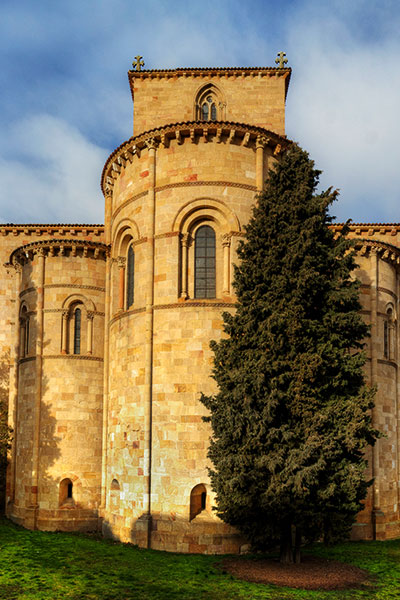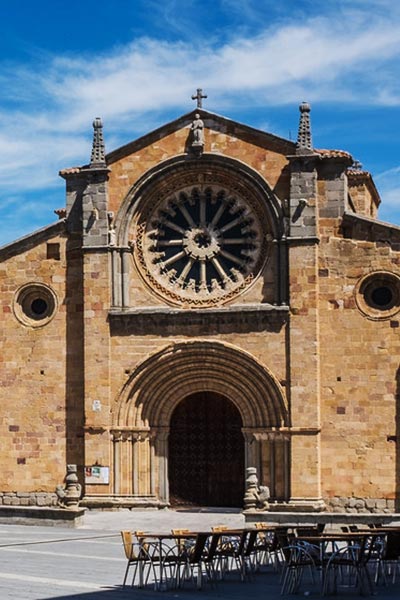Romanesque Route
Few Spanish cities have a Romanesque architectural heritage like that of Ávila.

Enjoy beautiful views
Most of the Romanesque churches that decorate our city are located outside the walls and, as a very curious case, placed in front of the gates or the arches of the wall. It is not surprising, because the population lived in the suburbs that were outside the wall, or because the spaces of the walled enclosure were very limited.
What will we visit on this route?
It is a route, that of the Romanesque, which is very interesting for the tourist or visitor of the city. Route with a special flavor, with samples as beautiful as we will see when traveling the next


ITINERARY
SAN VICENTE BASILICA
The Basilica of San Vicente, of cathedral dimensions, alone can justify a trip to our city. His style belongs to the purest Romanesque, although the dome of the temple is built in a Gothic key. The temple is dedicated to the saints Vicente, Sabina and Cristeta and rises where they were martyred and buried. Romanesque model and even Spanish. In it stands the cenotaph of the Saints. On the western cover are beautiful Romanesque sculptures. In the fifteenth century the arcaded gallery was built. It is a National Monument since 1923.
ST. PETER’S CHURCH
Romanesque temple second to none. It rises in the Plaza de Santa Teresa, in front of the Alcazar gate. Its Romanesque style belongs to the cycle of maximum purity with three superb apses and two excellent covers. It has a Latin cross plan; The central nave is larger than the lateral ones. The main facade has two bodies, the upper one dominated by a large rose window. Inside, the Renaissance altars and the altarpiece of the main chapel stand out. National Monument since 1914.
CHURCH OF SAN ANDRÉS
Beautiful Romanesque church with large central apse and two small lateral absidioli. It retains the most complete collection of Romanesque Abulense: lions, horses, harpies, pigeons, wolves, mosquitoes, faucets and plant motifs. Awesome Romanesque. On its western front is the tower, attached to the ship. The lobed arch in the southern absidiol draws attention. It is a National Monument since 1923.
HERMITAGE OF SAN SEGUNDO
It rises on the banks of the Adaja River. Small hermitage built in the 12th century. It has three ships and its head is closed with barrel and oven vaults. In it the prayerful sculpture of San Segundo is located, to which the Abulenses profess great devotion; its author was Juan de Juni. Declared National Monument in 1923.
CHURCH OF SAN ESTEBAN
It is one of the simplest Romanesque churches in the city and the only intramuros. It was built in limestone and has a powerful apse. The cover with archivolt decorated with rosettes of four petals. The decoration of its capitals is very valuable and stands out inside the staircase of the pulpit. National Monument since 1923.
CHURCH OF SAN NICOLÁS
Raised next to what was an Islamic cemetery. It belongs to the last Romanesque of the city. It has a unique apse to which an impressive tower is attached. In its base appears a granite boar. It was declared a National Monument in 1980.
CHURCH OF SANTO TOMÉ EL VIEJO
Located in the Plaza de Nalvillos in front of the Arco del Peso de la Flour. It is from the middle of the 12th century. Its two covers are semicircular arch with archivolts. Its main door is spectacular. Currently it has become a visitable warehouse of the Avila Museum. It was declared a National Monument in 1963.
CHURCH OF SANTA MARÍA DE LA CABEZA
It is located next to the old cemetery of the city of Ávila. Its construction has solutions from the Mudejar tradition and belongs to the last Romanesque Aboula. The body has three naves with arches bent in brick. The southern cover is topped with a small bulrush and in its triangular pediment a niche welcomes the image of the Virgin of the Head.
CHURCH OF SAN MARTÍN
Built outside the walls, north of the walled enclosure. It is of Romanesque origin. In the fourteenth century, its slender tower was built. In the XVI it was constituted the plant of three ships with semicircular arches. It has one of the most original towers of the architecture of the city. Its chairs and upper body are built with bricks by Mudejar masters. Declared National Monument in 1983.
